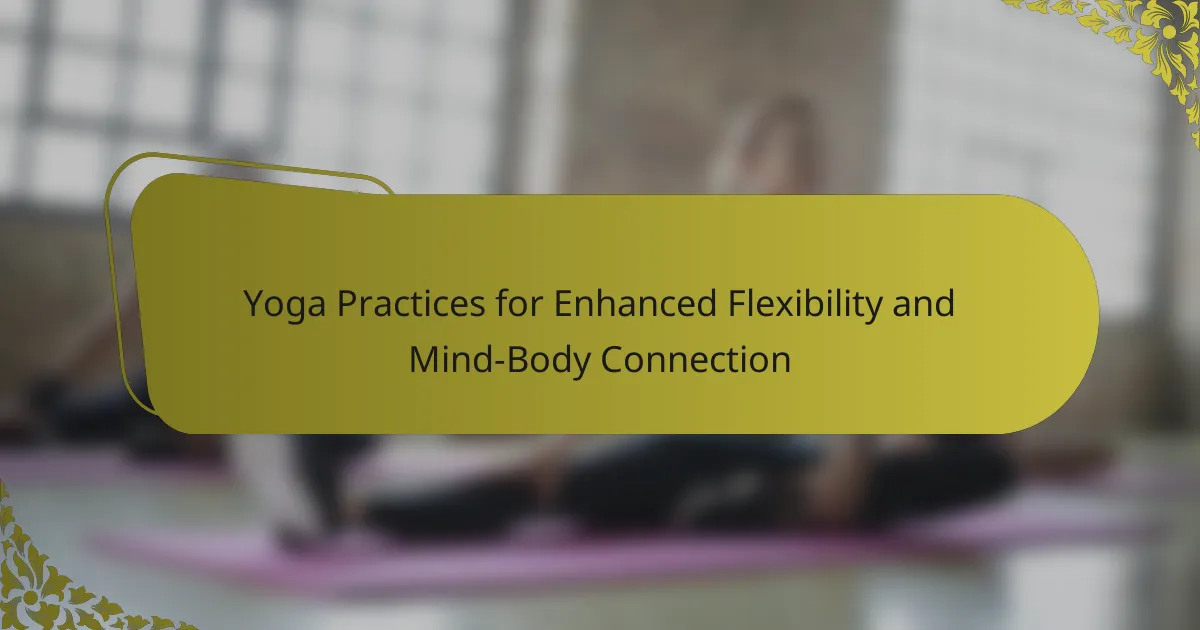Yoga practices enhance flexibility and strengthen the mind-body connection through targeted poses, mindful breathing, and consistent engagement. Techniques like dynamic and static stretching improve muscle elasticity and joint mobility. Various styles, including Hatha, Vinyasa, and Yin yoga, cater to different skill levels and flexibility needs. Addressing common challenges and maintaining a regular practice can lead to significant improvements in overall physical well-being.
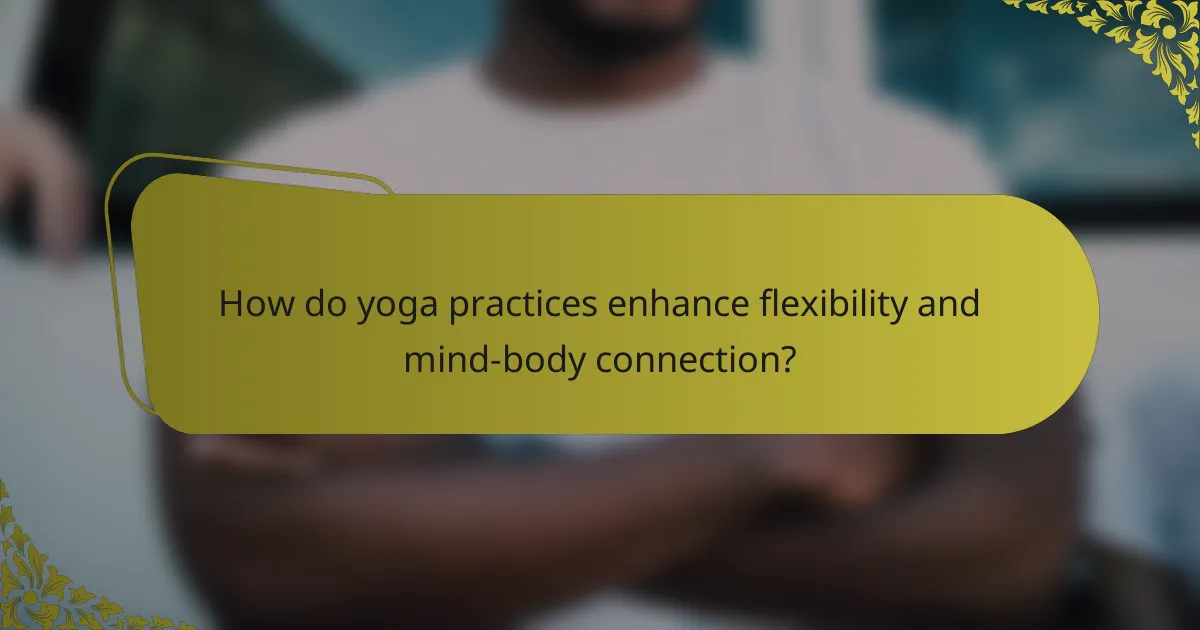
How do yoga practices enhance flexibility and mind-body connection?
Yoga practices significantly enhance flexibility and strengthen the mind-body connection through various techniques. Regular engagement in yoga improves muscle elasticity and joint mobility, allowing for greater range of motion. Poses such as Downward Dog and Forward Bend specifically target muscle groups, promoting flexibility over time.
Additionally, the mindfulness aspect of yoga fosters a deeper awareness of bodily sensations. This heightened awareness helps practitioners connect their mental state with physical movements, enhancing overall well-being. Research shows that consistent yoga practice can lead to improved mental clarity and reduced stress, further solidifying the mind-body connection.
Incorporating breath control techniques, such as pranayama, also plays a crucial role. Proper breathing supports physical poses and encourages relaxation, making it easier to maintain focus and presence during practice. Ultimately, yoga serves as a holistic approach to physical and mental health by intertwining flexibility and mindfulness.
What are the physiological benefits of improved flexibility through yoga?
Improved flexibility through yoga offers numerous physiological benefits, enhancing overall physical health. Increased flexibility reduces muscle tension and improves range of motion, which can lead to better performance in physical activities. Enhanced circulation promotes nutrient delivery and waste removal, supporting muscle recovery. Additionally, flexibility can alleviate discomfort and prevent injuries by allowing the body to move more freely. Regular yoga practice also fosters better posture, which contributes to spinal health and reduces strain on muscles and ligaments.
How does yoga facilitate a stronger mind-body connection?
Yoga enhances the mind-body connection by promoting mindfulness and self-awareness. Through various postures and breathing techniques, practitioners develop greater physical awareness, which translates to improved mental clarity. This holistic practice encourages the synchronization of breath with movement, fostering a deeper understanding of bodily sensations. As a result, individuals often experience reduced stress and enhanced emotional regulation. Regular yoga practice can lead to a unique ability to connect with one’s inner self, facilitating personal growth and resilience.
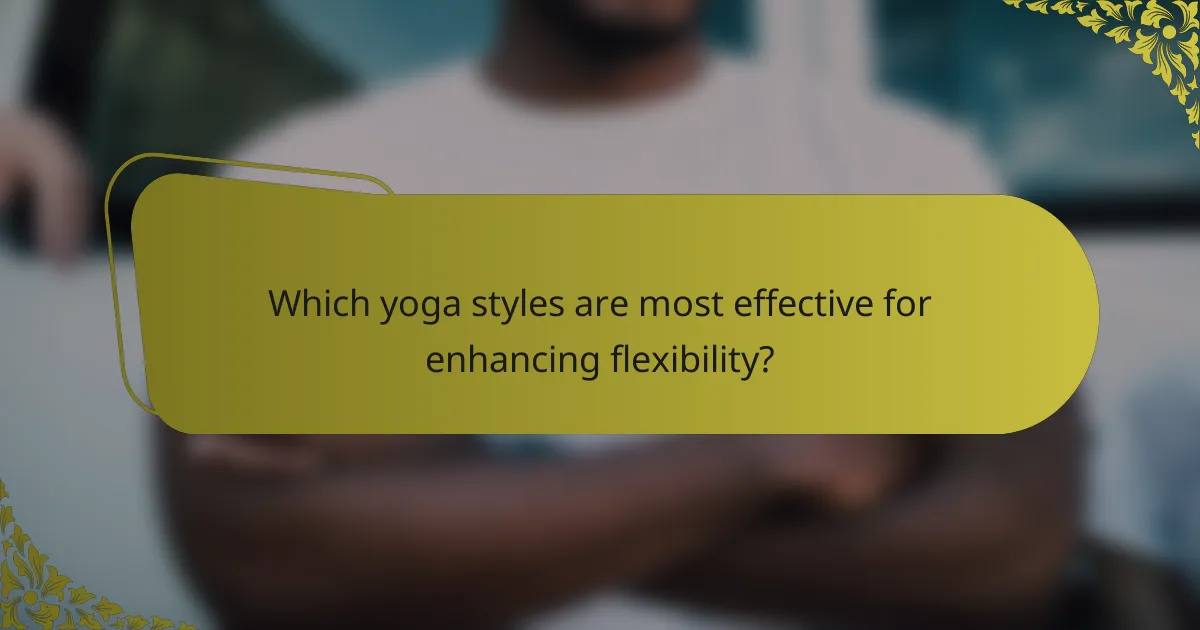
Which yoga styles are most effective for enhancing flexibility?
Hatha, Vinyasa, and Yin yoga are most effective for enhancing flexibility. Hatha yoga focuses on basic postures and alignment, promoting gradual flexibility improvements. Vinyasa yoga incorporates dynamic movements, linking breath with flow, which enhances overall range of motion. Yin yoga targets deep connective tissues through long-held poses, significantly increasing flexibility over time. Each style offers unique approaches to stretching and mobility, catering to different needs and preferences.
What are the specific benefits of Hatha yoga for flexibility?
Hatha yoga significantly enhances flexibility by promoting muscle elongation and joint mobility. Regular practice stretches various muscle groups, improving overall range of motion.
Additionally, Hatha yoga incorporates poses that target specific areas, such as hamstrings and hips, which can alleviate tension and increase elasticity. As a result, practitioners often experience reduced stiffness and improved posture.
Moreover, the emphasis on breath control in Hatha yoga aids in relaxation, allowing deeper stretches and further enhancing flexibility. This mind-body connection not only supports physical growth but also fosters mental clarity and focus.
How does Vinyasa yoga promote dynamic flexibility?
Vinyasa yoga promotes dynamic flexibility through its flowing sequences that connect breath with movement. This practice encourages muscle elongation and joint mobility, enhancing overall flexibility. The continuous transitions between postures improve range of motion and reduce stiffness. Additionally, the focus on breath control fosters a deeper mind-body connection, allowing practitioners to be more attuned to their bodies’ needs and limits. As a result, Vinyasa yoga not only increases physical flexibility but also cultivates mindfulness and awareness.
What role does Yin yoga play in deepening flexibility and relaxation?
Yin yoga significantly enhances flexibility and relaxation through long-held poses that target deep connective tissues. This practice encourages a meditative state, promoting mindfulness and a deeper mind-body connection. The extended duration of each pose allows muscles to gradually release tension, resulting in improved flexibility over time. Additionally, Yin yoga’s focus on breath and stillness fosters relaxation, reducing stress and anxiety levels. The unique attribute of this practice lies in its ability to cultivate both physical and emotional balance, making it a valuable tool for holistic well-being.
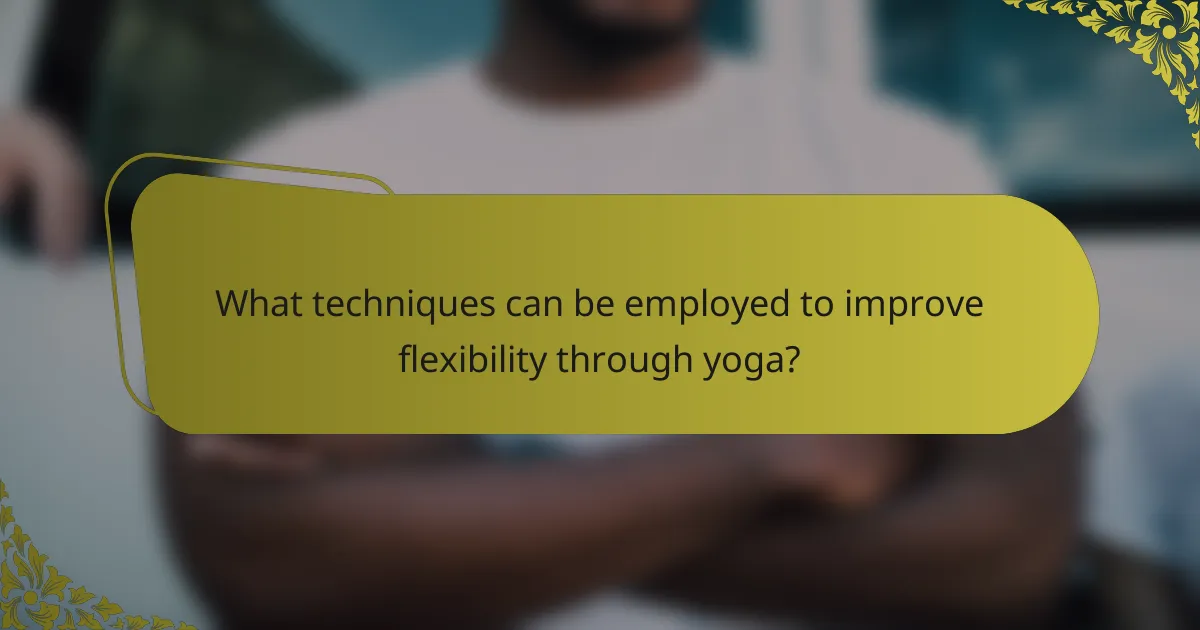
What techniques can be employed to improve flexibility through yoga?
Yoga techniques to improve flexibility include dynamic stretching, static stretching, and mindful breathing. These practices enhance muscle elasticity and promote relaxation, allowing for deeper stretches. Incorporating poses such as Downward Dog, Pigeon Pose, and Forward Bend can target specific muscle groups for greater flexibility. Regular practice fosters a stronger mind-body connection, contributing to overall wellness and physical performance.
How do breathing techniques influence flexibility during yoga practice?
Breathing techniques significantly enhance flexibility during yoga practice by promoting relaxation and increasing oxygen flow to muscles. This connection between breath and movement allows practitioners to deepen stretches and improve overall body awareness. Controlled breathing helps release tension, making it easier to achieve a greater range of motion. As a result, consistent practice of these techniques can lead to noticeable improvements in flexibility over time.
What are the most effective poses for enhancing flexibility?
The most effective poses for enhancing flexibility include Downward Dog, Pigeon Pose, and Forward Bend. These yoga practices stretch key muscle groups, improving overall flexibility and promoting a strong mind-body connection.
Downward Dog targets the hamstrings and calves, while Pigeon Pose opens the hips. Forward Bend enhances spinal flexibility and stretches the back. Regular practice of these poses can lead to significant improvements in flexibility over time.
Which poses specifically target hip flexibility?
Yoga poses that specifically target hip flexibility include Pigeon Pose, Butterfly Pose, Lizard Pose, and Frog Pose. These poses enhance hip range of motion and promote relaxation. Practicing them regularly can improve overall flexibility and support a deeper mind-body connection.
What poses are recommended for spinal flexibility?
Recommended poses for spinal flexibility include Cat-Cow, Downward Dog, Cobra, and Seated Forward Bend. These poses enhance mobility and promote a strong mind-body connection. Cat-Cow stretches the spine dynamically, while Downward Dog lengthens the entire back. Cobra opens the chest and strengthens the lower back, and Seated Forward Bend encourages deep stretching of the hamstrings and spine. Incorporating these poses into your routine can significantly improve spinal flexibility and overall well-being.
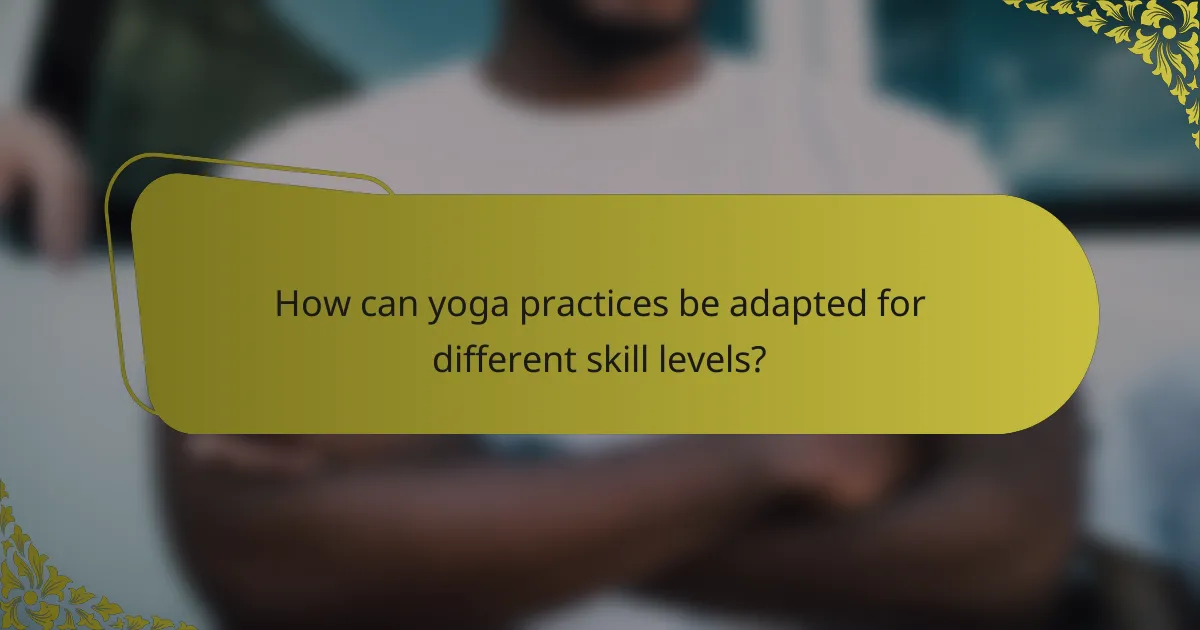
How can yoga practices be adapted for different skill levels?
Yoga practices can be adapted for different skill levels by modifying poses, adjusting duration, and incorporating props. Beginners can start with foundational poses while advanced practitioners can explore deeper variations.
1. **Beginner Level**: Focus on basic poses like Mountain and Child’s Pose. Use props for support.
2. **Intermediate Level**: Introduce variations like Warrior II and Tree Pose. Increase duration for deeper stretches.
3. **Advanced Level**: Explore complex poses like Crow and Handstand. Emphasize breath control and mindfulness.
4. **Restorative Practices**: Incorporate gentle stretches and relaxation techniques for all levels to enhance mind-body connection.
Adapting yoga ensures inclusivity and promotes flexibility, allowing practitioners to progress at their own pace.
What modifications can beginners use to enhance flexibility safely?
Beginners can enhance flexibility safely by incorporating modifications such as using props, practicing gentle stretches, and focusing on breath control. Utilizing blocks or straps can provide support in poses, allowing for deeper stretches without strain. Gentle movements, like cat-cow or child’s pose, help gradually increase range of motion. Prioritizing breath awareness enhances the mind-body connection, promoting relaxation and preventing injury. Consistent practice with these modifications fosters long-term flexibility improvement.
How can advanced practitioners further challenge their flexibility in yoga?
Advanced practitioners can further challenge their flexibility in yoga by incorporating dynamic movements, advanced poses, and breath control techniques. These practices enhance both physical flexibility and the mind-body connection.
1. Utilize dynamic stretching to increase range of motion before static poses.
2. Integrate advanced poses like Hanumanasana and Eka Pada Rajakapotasana to deepen flexibility.
3. Experiment with partner stretching for support and increased resistance.
4. Focus on breath control techniques, such as Ujjayi breath, to enhance relaxation and flexibility.
5. Incorporate props like straps and blocks to explore deeper stretches safely.
6. Attend workshops or classes that focus on flexibility and advanced techniques.
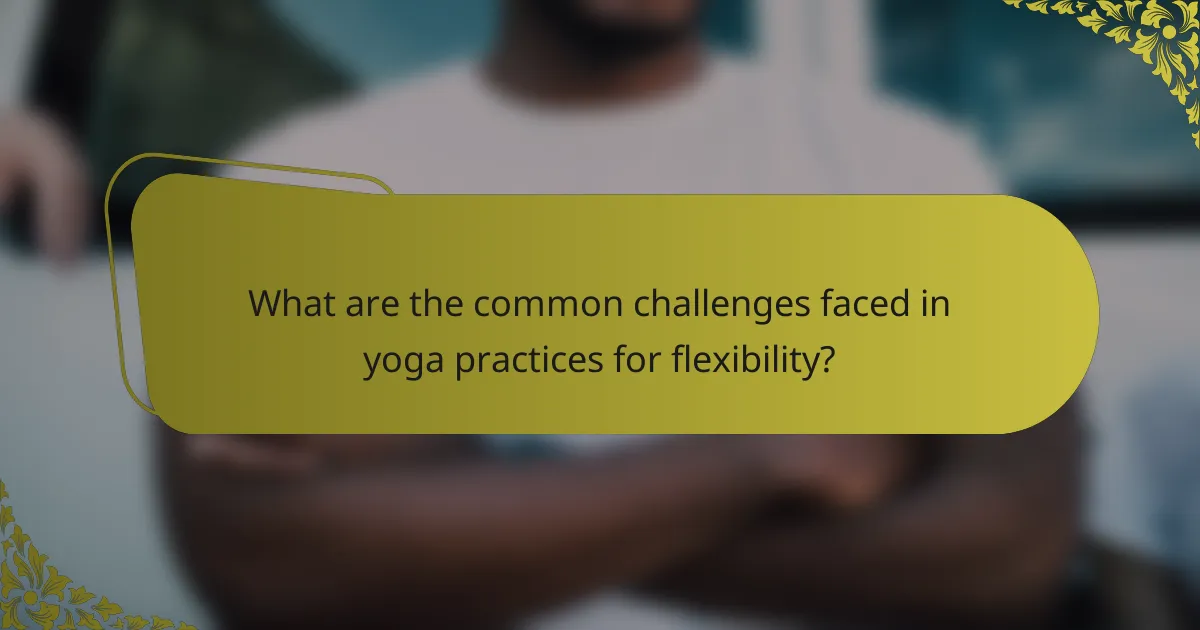
What are the common challenges faced in yoga practices for flexibility?
Common challenges in yoga practices for flexibility include limited range of motion, muscle tightness, inconsistent practice, and mental barriers. These factors can hinder progress and lead to frustration. For example, tight hamstrings may restrict forward bends, while a lack of regular practice can prevent muscle adaptation. Mental barriers, such as self-doubt, can also impact performance and motivation. Addressing these challenges through targeted techniques and consistent effort can enhance overall flexibility and the mind-body connection in yoga.
How can mental barriers impact flexibility in yoga?
Mental barriers can significantly hinder flexibility in yoga by creating psychological resistance. These barriers often stem from self-doubt, fear of injury, or negative self-talk, which can restrict both physical and mental openness. Overcoming these barriers enhances the mind-body connection, allowing practitioners to access deeper stretches and improve overall flexibility. Techniques such as mindfulness and positive affirmations can help mitigate these mental obstacles, fostering a more conducive environment for physical growth in yoga practice.
What physical limitations may hinder flexibility in yoga practice?
Physical limitations such as tight muscles, joint stiffness, and structural imbalances can hinder flexibility in yoga practice. These factors restrict the range of motion and can lead to discomfort during poses. Regular practice can improve flexibility over time, but addressing specific limitations is crucial. For example, incorporating targeted stretches can enhance muscle elasticity and joint mobility.
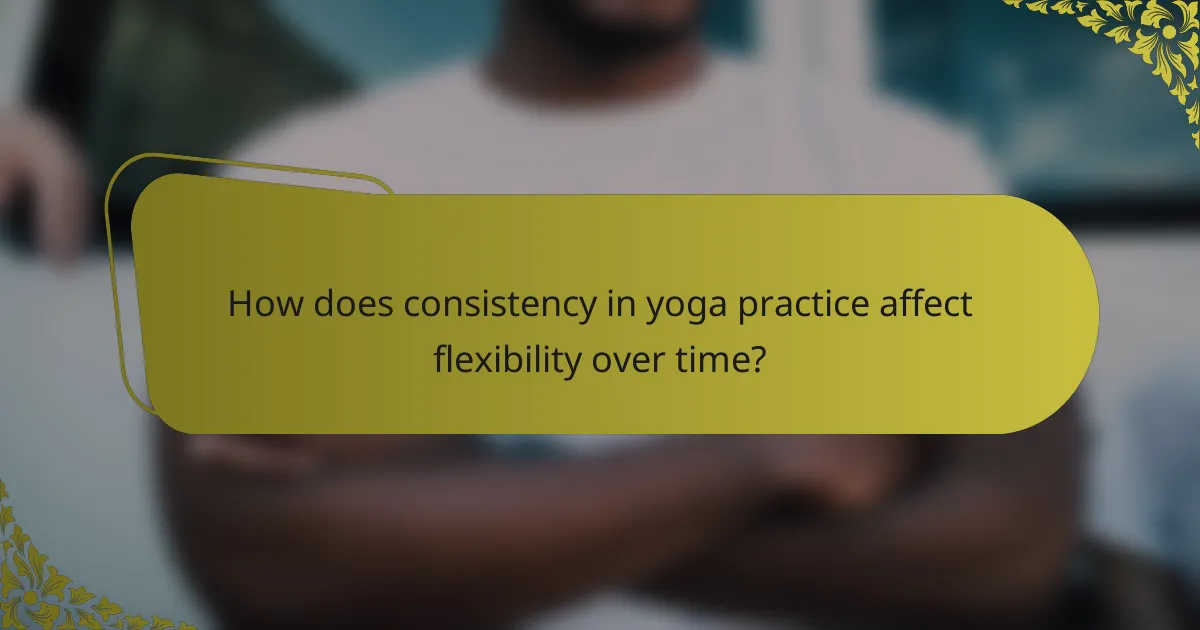
How does consistency in yoga practice affect flexibility over time?
Consistency in yoga practice significantly enhances flexibility over time. Regular engagement in yoga stretches and poses promotes muscle elasticity and joint mobility. Studies indicate that practitioners can experience substantial improvements in flexibility within a few weeks of dedicated practice.
The benefits of consistent yoga include increased range of motion, reduced muscle tension, and improved posture. For instance, practitioners often report enhanced flexibility in areas such as hips, hamstrings, and spine through targeted asanas.
Moreover, the mind-body connection cultivated through yoga reinforces these physical benefits. Mindful breathing and focus during practice can lead to deeper stretches and greater awareness of body limits.
Ultimately, the cumulative effect of consistent yoga practice leads to lasting improvements in flexibility and overall physical well-being.
What is the recommended frequency for practicing yoga to improve flexibility?
Practicing yoga three to five times a week is recommended to improve flexibility. Consistency is key, as regular sessions enhance muscle elasticity and joint mobility. Incorporating various styles, such as Hatha or Vinyasa, can target different muscle groups effectively. Additionally, listening to your body and adjusting frequency based on personal progress is essential for optimal results.
How long does it typically take to see improvements in flexibility through yoga?
Typically, improvements in flexibility through yoga can be seen within 4 to 8 weeks of consistent practice. Factors influencing this timeframe include the individual’s starting flexibility, the frequency of practice, and the specific yoga styles practiced. For example, dynamic styles like Vinyasa may yield faster results compared to restorative styles. Consistency and patience are essential for achieving significant gains in flexibility.

What role does mindfulness play in enhancing flexibility through yoga?
Mindfulness significantly enhances flexibility in yoga by promoting body awareness and relaxation. Practicing mindfulness allows individuals to connect deeply with their bodies, facilitating improved stretching and movement. This heightened awareness helps practitioners identify areas of tension and resistance, enabling them to approach poses with greater ease. As a result, mindfulness not only fosters physical flexibility but also nurtures a more profound mind-body connection, enhancing overall yoga practice.
How can meditation practices complement yoga for better flexibility?
Meditation practices can significantly enhance yoga by promoting mental focus and relaxation, which improve flexibility. Integrating meditation helps reduce tension in muscles, allowing for deeper stretches during yoga sessions. Additionally, mindfulness cultivated through meditation fosters a stronger mind-body connection, enhancing overall performance in yoga. Regular practice of both disciplines leads to increased body awareness, which is essential for achieving greater flexibility. As a result, practitioners often experience improved physical and mental well-being.
What are the benefits of incorporating mindfulness into yoga routines?
Incorporating mindfulness into yoga routines enhances mental clarity, reduces stress, and improves overall well-being. Mindfulness practices during yoga promote deeper awareness of the body and breath, fostering a stronger mind-body connection. Research indicates that mindful yoga can increase flexibility and balance while decreasing anxiety levels. Regular practice cultivates emotional resilience and encourages a positive outlook, making it a valuable addition to any yoga regimen.
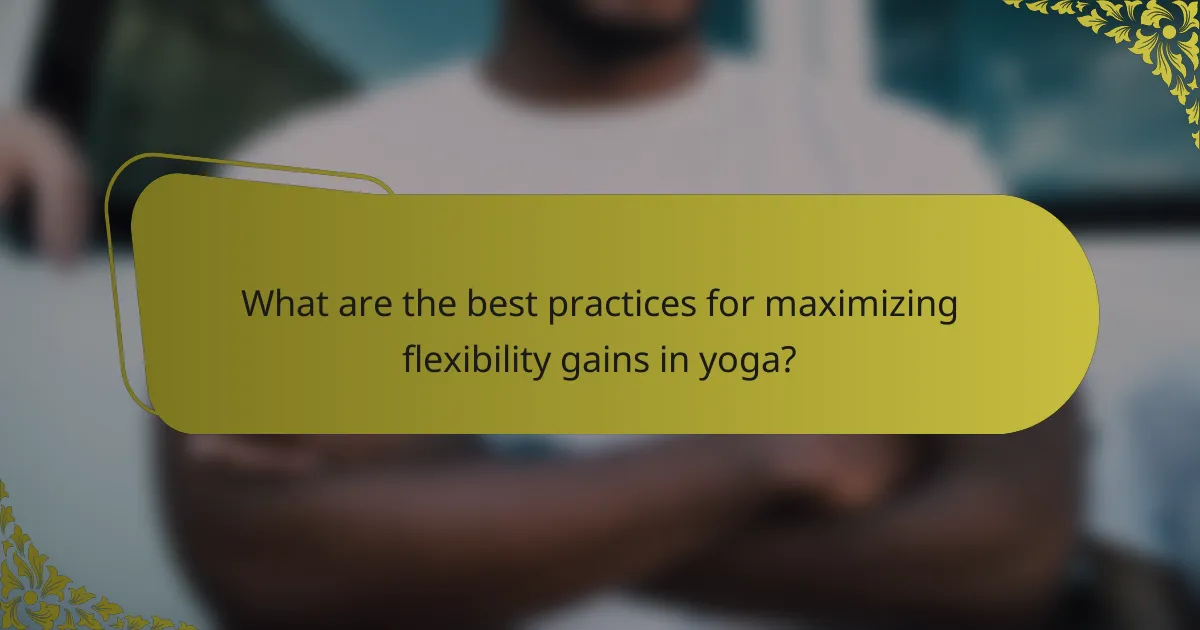
What are the best practices for maximizing flexibility gains in yoga?
To maximize flexibility gains in yoga, focus on consistent practice, proper alignment, and breath control. Incorporate dynamic stretches and hold poses longer to deepen the stretch.
1. Establish a regular yoga routine, aiming for at least three sessions per week.
2. Utilize props like blocks and straps to support your body in challenging poses.
3. Emphasize breath awareness to enhance relaxation and deepen stretches.
4. Gradually increase the duration of each pose to improve flexibility over time.
5. Explore a variety of styles, such as Hatha or Yin yoga, to target different muscle groups.
What common mistakes should be avoided during yoga practices for flexibility?
To enhance flexibility during yoga practices, avoid these common mistakes. Ignoring warm-ups can lead to injuries and restrict flexibility gains. Pushing too hard in poses may cause strain instead of improvement. Neglecting breath control can diminish the mind-body connection essential for effective practice. Practicing without proper alignment increases the risk of injury and reduces benefits. Lastly, skipping modifications for individual needs can hinder progress and cause frustration.
How can practitioners set realistic goals for flexibility improvement?
Practitioners can set realistic goals for flexibility improvement by assessing their current abilities and defining specific, measurable targets. Start with a baseline flexibility assessment to identify areas needing focus. Gradually increase the intensity and duration of yoga practices, incorporating various poses that target different muscle groups. Consistency is key; aim for regular sessions, ideally multiple times a week. Additionally, consider integrating mindfulness techniques to enhance the mind-body connection, which can support flexibility gains. Tracking progress over time will help maintain motivation and adjust goals as needed.
What expert tips can help enhance the mind-body connection through yoga?
Practicing yoga mindfully enhances the mind-body connection through focused breathing, intentional movement, and meditation. Incorporating these elements can deepen awareness and foster emotional balance.
1. Focus on Breath: Use deep, rhythmic breathing to center your thoughts and promote relaxation.
2. Set Intentions: Define personal goals for your practice to create a sense of purpose.
3. Incorporate Meditation: Spend time in stillness to cultivate mindfulness and self-awareness.
4. Explore Different Styles: Experiment with various yoga styles, such as Hatha or Vinyasa, to find what resonates with you.
5. Use Props: Incorporate blocks or straps to support your practice and enhance comfort, allowing deeper focus.
6. Reflect Post-Practice: Take a moment to journal or meditate on your experience to reinforce the connection.
